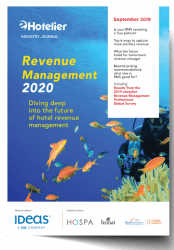 Different customer segments have different booking and staying patterns. Like a kaleidoscope, small recalibrations in their analysis can greatly influence key behaviours and bookings. What does your RMS system need to keep pace with accurate forecasts?
Different customer segments have different booking and staying patterns. Like a kaleidoscope, small recalibrations in their analysis can greatly influence key behaviours and bookings. What does your RMS system need to keep pace with accurate forecasts?
By the IDEAS Team
Hotel technology has advanced significantly over the last few years. Channels are evolving at a rapid pace, customers can compare options like never before, and even selling systems are finally seeing investment to keep pace. That said, few solutions hoteliers interact with are as analytically advanced as their revenue management system (RMS)—and it’s imperative these systems also keep up with business changes. So, do you know if your hotel’s RMS has what it takes to keep up?
The Right Rate & Segment Controls
Many RMS solutions roll up transaction data into aggregated groupings such as market segments, or simply classify reservations based on value alone. Unfortunately, important information is often lost as a result of this aggregation process—in particular, the information regarding how different rates are priced and controlled. Individually capturing information by transaction allows an RMS to separate these transactions based on factors that influence their key behaviors as well as critical aspects of the rates that influence how they should be priced and controlled. Once that is done, it is possible to build the most effective groupings to support accurate forecasting and optimization decisions.
Imagine we have two corporate rates: one is contracted at a fixed price, but the hotel can restrict availability for it as required on peak days. Meanwhile another corporate rate is contracted at a guaranteed 10 percent off the best available rate (BAR) with last room availability—meaning this rate cannot be restricted in its availability. These two rates will often end up in the same market segment, simply because they are both corporate contracted rates. However, from a revenue management—and particularly an advanced analytics—perspective, these two rates will behave differently and must be controlled differently.
There are many rate attributes that should be used to properly separate them into proper analytic groupings. Creating analytic groupings by differentiating how rates will be “controlled” in your RMS (along with other factors) will result in more optimal decisions and ultimately, better bottom-line performance. Meanwhile, forecasts can still be made available to revenue managers and other system users, including users from other departments, in a manner consistent with their current organizational reporting needs.
Read the full article in eHotelier Industry Journal: Revenue Management 2020. Exclusive to eHotelier members.































